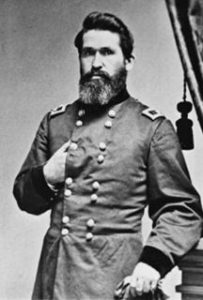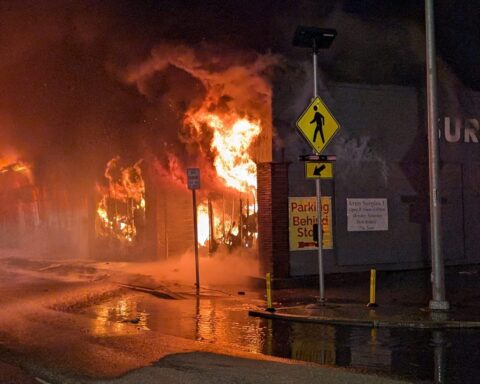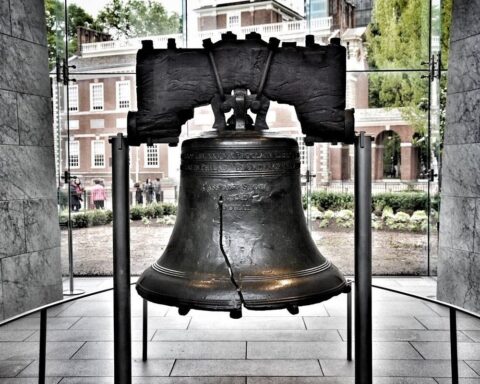(Continued from Part II)
Part III – Retreat to the Big Blue
Brigadier General James Gilpatrick Blunt wasn’t supposed to fight at the Little Blue. Concerned about breaking down his best regiments, the Eleventh, Fifteenth, and Sixteenth, General Curtis had originally ordered Blunt to leave Moonlight and 400 men on the western bank and to join up with the Kansas militia units at the Big Blue. But the area around the Little Blue was a good place for fighting.

Although the stream was fordable by men nearly everywhere, its banks were lined with a series of stone walls and enough timber to provide a defending force – especially one with good arms – enough cover to make a stand. Moonlight, with about 600 men of the Second Brigade and four mountain howitzers, was tasked with holding the western bank briefly and burning the only nearby bridge to make it more difficult for Price to get his artillery across, and to notify Blunt when it had been crossed.
Price had placed the division of Brigadier General John S. Marmaduke in the advance. Though they found the bridge burning upon their arrival at sunup of October twenty-first, his men began crossing the river immediately and quickly located a ford suitable for the guns a half-mile to the south.
Blunt and Curtis began that morning in Independence, Missouri, eight miles west of the Little Blue. Because of the arrival of a number of local units the previous day, Blunt was able to organize a Fourth Brigade (there was no third), made up of existing units from the First and Second, namely the Colorado Cavalry and Battery units and the Kansas Sixteenth. Several the recently-arrived units, including Foster’s Cavalry Battalion (Missouri Volunteers), were added to the First Brigade under Jennison.
Independence itself lacked natural defenses and thus could be easily surrounded the moment Price crossed the Little Blue in force. Therefore, Deitzler was sent back to the Big Blue to ensure that defensive arrangements were ready for the expected stand there. General Curtis, with Blunt and his reorganized cavalry, moved forward towards the Little Blue to help cover Moonlight’s expected retreat. When they arrived, they found him heavily engaged, but having fallen back only two miles from the river in three hours of fighting. They quickly integrated their newly arrived troops into Moonlight’s lines, with the Fifteenth on the far right. Jennison, being responsible for the entire First Brigade, organized firing positions for the howitzers that Foster’s Batallion had brought with them.
The Union’s advantage in weaponry allowed Moonlight’s brigade to hold the center even while falling back – Marmaduke’s division quickly became so beat up that Price had to send Shelby to reinforce him. But the overwhelming number of troops Price had available allowed him to continuously flank the Union line on both right and left. Hoyt led the Fifteenth on repeated charges into Shelby’s two brigades with the rally cry “Remember Lawrence!” – one in particular was “spoken of in the most enthusiastic terms” and earned him the sobriquet “Hero of the Blue.” But over a period of eight back-and-forth hours, late into the afternoon, the Fifteenth and the whole cavalry division of the Army of the Border found themselves pushed into and through the town of Independence itself, and toward the waiting defensive lines along the Big Blue. As the retreating Union forces passed through the town, they were scoffed and shot at by a few of its more southern-minded residents. One lieutenant of the Second Colorado, a unit previously stationed in Independence, was wounded in the shoulder by a woman who shot him through an open window.
Because Price’s army had been located only a few days earlier, Deitzler had lacked enough time to organize the still-arriving Kansas Militia effectively. Senator Lane had been burned in effigy in Shawnee, Kansas, by militiamen convinced that the whole invasion was a scheme cooked up by Lane to get hostile Kansas voters out of the state for election day. Lane, acting as an aid-de-camp for General Curtis, took the opportunity to write to the Kansas Daily Tribune from Lexington, informing Kansans that not only had Price’s location been confirmed, but that the whole country was swarming with the guerrillas he had gathered about him on his sweep through Missouri, an assertion guaranteed to get the attention of skeptical Kansas readers. Though the feared Quantrill himself was not present, two of his best-known lieutenants had come. Lane solemnly informed his readers that, “[George] Todd and [Dave] Poole started for Kansas with three hundred cutthroats yesterday,” being forced to turn back only because all of Kansas was in arms. But he hastily added, “the place to watch is on the border in this state.” Kansans, he reminded his audience with a more than a hint of satisfaction, now had their chance – and the army’s belated permission – to invade Missouri after all.
George Todd had indeed returned, if he had ever left Shelby’s side to begin with. As Price crossed the state westward, he had gathered into his forces a large number of the guerrilla companies that plagued the state, though others, like “Bloody” Bill Anderson’s north of the Missouri River, operated more or less in conjunction with the anarchy Price’s advance was causing there. Todd, who expelled William Quantrill from his own band and was now leading its troops, had met up with General Price’s forces on the fifth of October. For the three weeks that followed, Todd’s partisan rangers provided invaluable scouting services to Price, who was traveling through the guerrillas’ own stomping grounds. His men also proved excellent marksmen who constantly harassed Union forces, whether scouting, charging, or retreating, from protected positions in the brush.
As Shelby’s cavalry pushed the Union forces past the courthouse in the center of Independence, Todd rode out to the front of Shelby’s line to get a better look at the Fifteenth and the Colorado Second, who were at last leaving the town. From across the courthouse square, Hoyt shot him through the neck, killing him instantly. When Todd’s men elected Dave Poole their new captain the next day, Poole pulled them out of Price’s army and led them back east.
Shaking free of the hostile streets of Independence, Hoyt led the remnants of the tired, retreating Fifteenth across open fields toward the Big Blue, where Kansas militia units mingled atop the bluff that graced its western bank. Upon their arrival, they heard General Curtis announce Sheridan’s victory in the Shenandoah Valley. As the darkness grew around them they rested and waited within the treeline overlooking the river, listening to final work being done on the defensive preparations they thought would either deny Kansas to Price, or leave it wide open to his forces.
They did not know that about that same hour, Pleasonton arrived at the Little Blue.
(Continued in Part IV)

Tarnished Brass – A History of the Kansas Fifteenth Volunteer Cavalry, Part III
Latest from History

Dangerous Left Wing Rhetoric
On Saturday, July 13, 2024, an assassin came within inches of murdering Donald Trump on a live broadcast. Democrat talking heads immediately split into two camps: some said Trump staged the shooting

Revolution, Independence, and Union – Part 6
The good effects of the American revolt on British politics have it would seem been overrated. Whatever Chatham or any one else might say in his oratoric mood, there was little danger

Revolution, Independence, and Union – Part 5
It was in the dark hour before the arrival of French aid that treason entered into the heart of Benedict Arnold, the commander of the all-important lines upon the Hudson. Arnold had

Revolution, Independence, and Union – Part 4
The Netherlands, when they rose against Spain and the Inquisition, had a cause terribly great and showed spirit as great as their cause. The cause in which the Americans rose against the

Revolution, Independence, and Union – Part 3
The war opened at Boston, where General Gage, now its military governor, lay with a small army of occupation and repression, and it opened in a way ominous of the final result



